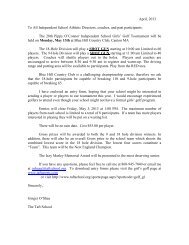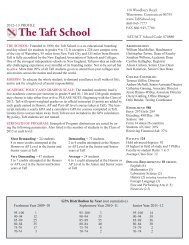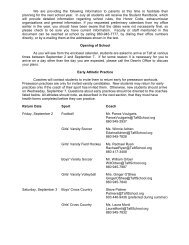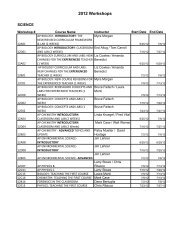ManufactuRed Housing - The Taft School
ManufactuRed Housing - The Taft School
ManufactuRed Housing - The Taft School
Create successful ePaper yourself
Turn your PDF publications into a flip-book with our unique Google optimized e-Paper software.
Step Two:Divide Up the WorkIf we assume that the world’s developing nations pursue themost aggressive reductions that can reasonably be expected ofthem, the world’s industrialized nations will have to reducetheir emissions an average of 70 to 80 percent below 2000levels by 2050. Industrialized nations’ share of the cumulativeemissions budget must be no more than 700 GtCO 2eq (approximately40 percent of the budget).This 70 to 80 percent range for reductions by 2050 alsoassumes that industrialized nations’ emissions will peak in2010 before starting to decline, and that those from developingnations will peak between 2020 and 2025. A delay inthe peak of either group would require increasingly steep andunrealistic global reduction rates in order to stay within thecumulative emissions budget.Step Three:Define Our National Goal<strong>The</strong>re are several ways to determine the United States’ share ofthe industrialized nations’ emissions budget. Our analysis exploredthree methods, including allocations based on the currentU.S. share (among industrialized countries) of population, grossdomestic product (GDP), and heat-trapping emissions. Usingthese criteria, the U.S. cumulative emissions budget ranges from160 to 265 GtCO 2eq for the period 2000–2050, of which approximately45 GtCO 2eq has already been emitted.Given our aggressive assumptions about reductions byother nations and the fact that a stabilization target of 450ppm CO 2eq represents the upper limit needed to avoid apotentially dangerous temperature increase, we propose thatthe United States should reduce its emissions at least 80percent below 2000 levels by 2050.<strong>The</strong> costs of delay are high. To meet this minimum target,starting in 2010 the United States must reduce its emissions,What Happens IfTemperatures Rise More Than 2°C?Scientific studies indicate that crossing this temperature threshold will increase the riskof potentially severe impacts in the following areas.Sea level. Sustained warming between 1.6°C and 5.2°Cabove pre-industrial levels could initiate widespread destabilizationof the Greenland and West Antarctica ice sheets, leading tosea level rise between 12 and 40 feet. While the full increase maytake centuries to occur, even an increase of one meter (aboutthree feet) would threaten major cities including Mumbai, NewYork, and Tokyo, and inundate some small islands. Rising seasalso magnify the destructive potential of coastal storms; projectionsshow a mere 7- to 14-inch rise could produce flooding inBoston and Atlantic City, N.J., equivalent to today’s 100-yearflood almost every year on average.Wildlife. Even 2°C to 3°C of warming could threaten 20to 30 percent of Earth’s species with extinction, accordingto the Intergovernmental Panel on Climate Change (IPCC).Many coral reefs would become bleached at these temperaturethresholds, and marine ecosystems could suffer from increasingocean acidification.Weather-related events. Warming in this range hasbeen linked to increases in the severity of floods, droughts,fires, and heat waves. A 2.4°C increase, for example, wouldcause many cities across the northeastern United States to experiencea projected tripling in the number of days with hightemperatures above 32°C (90°F), increasing the risk of heatrelatedillness and death among vulnerable populations.Water resources. In the continental United States,drought-prone ecosystems are projected to expand approximately11 percent in area for each degree Celsius of additionalwarming. Worldwide, 1 to 2 billion people would be at risk ofincreased water scarcity.26 <strong>Taft</strong> Bulletin Spring 2008
















